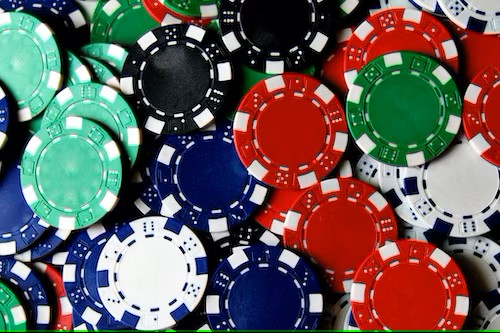There’s a well-known gambling community saying: “Counterfeiting real money is easier than counterfeiting casino chips.” When you come across this saying, it prompts you to wonder about the difficulty of counterfeiting casino chips and whether it’s possible to get away with it.
To address both of these inquiries, casino managers and goers alike firmly believe that counterfeiting casino chips in the present day is exceptionally challenging, and it is strongly advised against attempting it.
Suppose you’re interested in understanding the rationale behind this assertion, learning about the manufacturing process of casino chips, and uncovering the truth behind common misconceptions about them.
In that case, we encourage you to read the entire article! Casino chips are considered a currency, and creating fake chips to defraud casinos has always been a concern. Casinos have consistently recognized these risks and taken measures to prevent potential losses from such activities.

Photo by Unsplash
Properties and Values of Casino Chips
The specialized markings on casino chips indicate their origin and serve as a form of currency within the casino realm. Casinos may accept “foreign” chips, primarily if owned by the same operator, although certain limitations exist. Chips without a casino logo are immediately identified as counterfeit.
Over time, standard color coding has been established for chip values. For example, blue or white chips represent $1, red chips (nickels) represent $5, green chips (quarters) represent $25, black chips represent $100, purple chips (Barneys) represent $500, and orange chips (pumpkins) represent $1,000. Even within these colors, various shades make it difficult for counterfeiters to match precisely.
Furthermore, the colors of the chips not only indicate their values and deter counterfeiting but also serve to denote table limits. Signs at table games feature different colored chips to signify the minimum wager required. A green sign indicates a $25 minimum bet, while a black sign indicates a $100 minimum.
What is the process of manufacturing casino chips like?
The manufacturing of casino chips has undergone significant advancements over the years, drastically different from the chips used in casinos half a century ago. Presently, manufacturers employ sophisticated and costly machinery to guarantee consistent and identical casino chips with no variations in quality.
What are the current counterfeiting measures?
The casino industry acknowledges the risks of counterfeiting and has implemented various anti-counterfeit measures in casinos. However, many of these measures need to be updated and easily counterfeited compared to others.
Before discussing a more effective method of safeguarding casino chips, let’s review the typical range of protections. Over the years, the production process of casino games chips has undergone significant advancements, vastly different from what gamblers used decades ago. Modern-day live casino chip manufacturers employ precise and expensive equipment to ensure consistent production, eliminating variations between each chip.
- Serial Numbers
Certain high-end casinos utilize casino chips that are marked with printed serial numbers. Although this practice does not directly prevent scammers from using counterfeit chips, it is a valuable tool for mitigating the financial impact of such scams.
Each casino chip carries a unique serial number, enabling the casino to effectively track and identify specific groups of counterfeit chips believed to be involved in a scam. As a result, scammers are left with worthless chips that cannot be exchanged for cash within the casino. This approach helps protect the casino from significant losses caused by counterfeit chip usage.

Photo by Unsplash
- Cool Holographic Images
Historically, holographic images were considered reliable protection due to limited access to the underlying technology. However, in today’s world, it has become relatively easy to purchase holograms online and apply them to counterfeit casino chips. This exposes the vulnerability of relying solely on holographic images as a counterfeit safeguard.
While holograms may appear technologically advanced, their widespread availability has made them easier to replicate compared to previous times. Although imprinting holograms on casino chips was a positive development, they are no longer considered the standard in anti-counterfeit measures.
- RFID chips
RFID chips are incorporated into high-denomination casino chips, particularly those used at the poker table or exclusive high roller areas, providing additional security. The inclusion of RFID technology makes counterfeiting these chips virtually impossible, as the casino maintains strict control over chips equipped with RFID tags.
- Custom Colors
In the past, utilizing custom color combinations and markings on the edge of casino chips may have been effective, but the landscape has changed significantly. Nowadays, technology plays a crucial role in chip design, presenting advantages and disadvantages.
Criminals can exploit these technologies to counterfeit casino chips by deciphering the accurate dimensions, material composition, and “invisible” markings specific to a particular denomination. Consequently, using custom color combinations and designs on the chip edge is no longer an effective method to combat counterfeiting.
- The Eye in the Sky
Lastly, while not directly related to the manufacturing process of chips, camera monitoring is a crucial tool in preventing counterfeit casino chip scams. Contemporary casinos employ advanced surveillance systems that extensively cover each table, making it highly challenging for scammers to introduce fake chips to the dealer without detection surreptitiously.
How Can You Tell if A Poker Chip is Fake?
Determining the authenticity of poker chips can be challenging, as they are frequently targeted for counterfeiting. The quality of counterfeit chips can vary greatly, with some closely replicating the appearance and texture of genuine poker chips, while others are poorly made and easily identifiable as fakes.
Several factors should be considered to assess the legitimacy of a poker chip. First, examine the paint and inlay graphics on the chip. Additionally, compare the material of the chip to others in your stack to ensure consistency. However, it is essential to note that some counterfeit poker chips can be so well-crafted that they are difficult to distinguish from genuine ones.

Photo by Unsplash
A helpful guideline is to pay close attention to poker chips with higher denominations. Scammers often prioritize counterfeiting chips with more excellent value as they yield greater rewards. Producing intricate designs and using high-quality materials are costly endeavors, leading top-level counterfeiters to focus on replicating higher-denomination chips. Conversely, lower denomination chips may receive extra attention from counterfeiters.
It is worth noting that even with these guidelines, it is still possible for skilled counterfeiters to produce convincing replicas. Therefore, it is advisable to exercise caution and rely on reputable sources when acquiring poker chips to minimize the risk of ending up with counterfeit ones.
What Do You Do When You Find One?
If you come across a poker chip, whether genuine or counterfeit, the best course of action is to promptly return it to the casino and provide an explanation of how you came to possess it. Unlike money, the “finder’s keepers” policy does not generally apply to chips.
Casinos typically have regulations stipulating that any lost or unclaimed fragments belong to the establishment. Consequently, keeping a chip found on the floor and attempting to cash it out can be considered theft, potentially resulting in severe consequences such as being banned from the casino or facing legal penalties.
To adhere to ethical standards and avoid complications, following the proper procedures and reporting the discovery of a poker chip to the casino is essential. By doing so, you demonstrate integrity and respect for the establishment’s rules, ensuring fair and transparent handling of the situation.